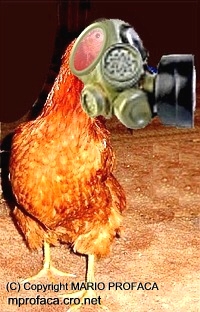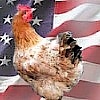   |
 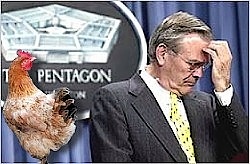
a low-tech chemical detection system Science World, April 18, 2003 Marines stationed in Kuwait recently purchased 43 chickens--and not for a barbecue. The live chickens were to serve as a low-tech chemical detection system, like the canaries coalminers once used to detect poisonous gases underground. "While chickens have lungs like we do, they also have something called air sacks," says bird specialist Ian Tizard at Texas A&M University. "If something really nasty is in the air, it would kill a chicken faster than it would a human." Sadly, all but two of the marines' chickens have already died--from illness, not chemical weapons. Should Operation Kuwaiti Field Chicken (KFC) be scrapped? Chickens are reportedly on standby in Kuwait to help in what is reportedly called Operation Kuwaiti Field Chicken. Yes, that's KFC for short, but the Pentagon's program is no joke. According to Time Magazine, if there is a war with Iraq, U.S. marines and soldiers will drive into battle with caged chickens on their military vehicles, watching the birds for any signs of exposure to chemical weapons. It's not the first time chickens have served Uncle Sam. Fowl were on duty as well in the Gulf War. "A sky full of oil can mask some chemicals," said Warrant Officer Jeff French, a nuclear, biological and chemical officer for a marine battalion in Kuwait, in an interview with Time. "Using chickens may sound basic, but it's still one of the best ways we have of detecting chemical agents." (Source: CBS)  U.S. troops will be using poultry to detect chemical attacks in Iraq By Simon Robinson, south of the Kuwait-Iraq border 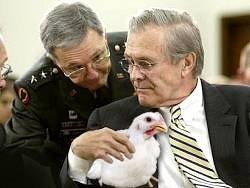 Feb. 21, 2003 - A war against Iraq will see the debut of some of the most sophisticated weaponry ever used. But U.S. Marines will also rely on one of the most low-tech detection devices around: chickens. Worried that the pollution from blown oil installations will clog up complicated detection equipment and make it difficult to pick up deadly chemicals and nerve agents, U.S. marines will drive into battle across the dusty plains of Iraq with caged chickens atop their Hum-Vees.
Feb. 21, 2003 - A war against Iraq will see the debut of some of the most sophisticated weaponry ever used. But U.S. Marines will also rely on one of the most low-tech detection devices around: chickens. Worried that the pollution from blown oil installations will clog up complicated detection equipment and make it difficult to pick up deadly chemicals and nerve agents, U.S. marines will drive into battle across the dusty plains of Iraq with caged chickens atop their Hum-Vees. The chickens, which were otherwise destined for Kuwaiti dinner tables, will work in the same way as canaries in coal mines used to. Small traces of poisonous gases or chemical agent will kill the birds or Poultry Chemical Confirmation Devices, as the Marines call them and warn troops to put on their gas masks. 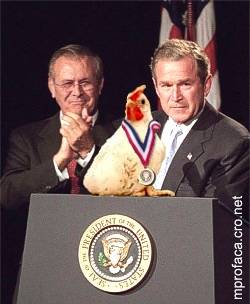 "A sky full of oil can mask some chemicals," says Warrant Officer Jeff French, a nuclear, biological and chemical officer for a marine battalion in Kuwait. "Using chickens may sound basic but it's still one of the best ways we have of detecting chemical agent." "A sky full of oil can mask some chemicals," says Warrant Officer Jeff French, a nuclear, biological and chemical officer for a marine battalion in Kuwait. "Using chickens may sound basic but it's still one of the best ways we have of detecting chemical agent." Dubbed Operation Kuwaiti Field Chicken (KFC), the use of chickens is sure to enrage animal activists. But chickens were used to detect for chemicals during the first Gulf War and, says French, consider that the alternative may be dozens of dead troops. Consider too that marines and soldiers will face nerve-racking moments with or without chickens. U.S. troops in Kuwait have been training to fight and live in their protective suits but at some point after a chemical attack they will have to take them off. After testing for chemicals, one or two men usually of different sizes and races will remove their masks in a "selective unmasking." Those who keep their masks on will study the skin and pupils of the unmasked for symptoms of lingering airborne chemicals. "Using chemicals is a really unfair way of fighting," says French. "The best way to describe it is if I blindfolded you and came and kicked you in the groin as hard as I can. It's just not fair. But whatever Saddam throws at us, we'll be ready."
By Drew Cullen, The Register
No, they won't be packed with explosives - like the kamikaze camels of Afghanistan. Instead they will sit "in cages atop Humvees, used as early warning gas detectors," the BBC reports. But are the chickens made of the right stuff? Early indications are not encouraging. "The US Army calls the strategy Operation Kuwaiti Field Chicken - or KFC - but the plan has been put on hold after 41 of the 43 chickens deployed to the Gulf died within a week of arrival." So what about the Navy Seals? Or to be more precise, Navy Sea-Lions, 20 recruits, all graduates of the US Navy's Marine Mammal Programme in San Diego, California. And they beat the crap out of dolphins when it comes to marine warfare. Says the BBC. "the Navy opted to use sea lions because they are more manoeuvrable than their cetacean counterparts and better able to handle the higher temperatures in the region." They will be earning their keep in the Gulf "by protecting US and British warships against attacks from underwater saboteurs and mines". There is a technology arms race out there. Keep up! ®  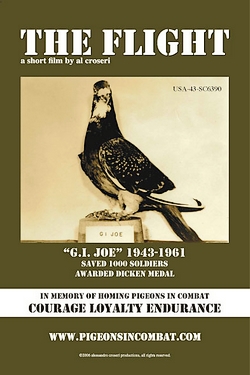
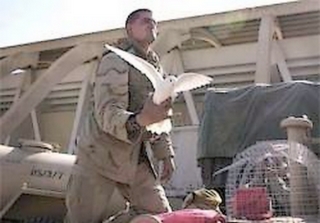 save lives in war time (Laura Rauch / Associated Press, Apr 13, 2003) Cpl. Scott Peck releases a pigeon in Baghdad, Iraq. The Marines use pigeons to detect chemical attacks. Marines of the 7th Regiment brought in pigeons to take over for the 42 chickens that died By Siobhan McDonough, Associated Press, Apr 03, 2003 WASHINGTON This materiel not only has bite, it's got plenty of bark. And beaks and bottle noses and feathers and flippers. Chickens, dogs, and dolphins have been given their marching orders to help protect U.S. troops in Iraq. Chickens defy death in cages atop U.S. military Humvees to detect a possible Iraqi chemical attack. Well, some don't exactly defy death. Most expired after a short stint in the Iraqi desert flu is suspected and pigeons have taken their place. Dogs, long used in warfare for scouting, relaying messages, and rescuing injured soldiers, are sniffing out bombs in Iraq. And dolphins Makai and Tacoma are helping to clear mines. Warfare has long depended on the fowl, the feathered, and the four-legged, whether they were elephants bearing javelin-throwers on the battlefields of the ancient world, camels spooking Byzantine cavalry horses with their pungent smell, or Spanish Conquistadores' mastiffs hunting down Peruvian Indians. "Without animals, historically, war as we know it would have been flat-out impossible," said Dennis Showalter, history professor at Colorado College. "If human beings had to carry the weight of food they ate, munitions they use, on their own backs and feet, we might have stayed closer to our homes." Coalition forces brought in the two bottle-nosed Atlantic dolphins to detect sea mines in the British-controlled Iraqi port of Umm Qasr something they are trained to do without setting off the explosives. "Now we have humans, machines, and animals working together to clear the mines in Iraqi waters," said Tom LaPuzza, spokesman for the Navy's marine mammal program in San Diego. LaPuzza calls dolphins' ability to detect things at a long distance "the best show in town." Sea lions have also been sent to the Persian Gulf and are being tested to see whether they can capture an enemy diver poised to attack a ship or pier. Bearing a clamp inside their mouths, the swift creatures approach a swimmer from behind and attach the clamp, connected to a rope, to his leg. Sailors aboard ships can fish the swimmer out of the water. The sea lions also can be used to recover military hardware or weaponry in the ocean. Marines of the 7th Regiment brought in pigeons to take over for the 42 chickens that died. If the birds, riding with a caretaker, get sick, that could signal a chemical attack, giving Marines some time to don gas masks a role once played by canaries in coal mines. Animal rights activists say creatures don't belong on the battlefield. "Making these birds participate in our wars is not only cruel and unjust, it is a betrayal of the men and women who are serving under you," Machipongo, Va.based United Poultry Concerns said in a letter to President George W. Bush. The group said that many of the chickens will die of hunger, thirst, and oxygen deficiency while being driven across a desert, and that there are better ways to do the job with sophisticated chemical detection systems. Showalter agrees, but makes a case for the chicken as placebo. "They help people feel better because a chicken is alive and we will trust a living thing's reaction to gas before something mechanical," he said. Dogs have served in the U.S. military during every modern war from World War I to Afghanistan, as trackers, scouts, sentries, messengers, attackers, mine detectors, and rescuers. The Vietnam Dog Handlers Association has proposed a National War Dog Memorial for Washington. About 4,000 war dogs served U.S. armed forces during the Vietnam war, according to the group. Horses were considered the supreme war animal from the end of the Bronze Age through the 19th century, and they still have a place in battle. In the Afghan war, U.S.-backed rebels galloped against the Taliban, sometimes joined on steeds by American soldiers, half a century after the United States dissolved its last mounted fighting unit. Horses have proved a handy way to move fighters and supplies in Afghanistan's rugged terrain.
Thailand offers chickens for arms  BBC News, Sep 3, 2004 BBC News, Sep 3, 2004Thailand and Russia are reportedly considering a deal in which Bangkok buys Russian weapons in return for large quantities of Thai chicken. A Thai team is due to leave for Russia this weekend to discuss the proposal. Thailand has vast stockpiles of frozen poultry, and hopes to sell up to 250,000 tonnes to Russia, a government official told Reuters news agency. Before it was hit by bird flu last year, Thailand was one of the world's largest chicken exporters. Bangkok has been offering cheap credit to Asian nations willing to buy poultry that its largest customers, the European Union and Japan, have refused to take. Earlier this week, Thai Prime Minister Thaksin Shinawatra said he had ordered his ambassador in Moscow to offer chicken for weapons, and said he would consult military chiefs on what arms they wanted. He did not mention whether warplanes were likely to be on the list, but the official told Reuters that Bangkok was interested in Russia's Sukhoi Su-30 fighter planes. Most of Thailand's air force has traditionally been equipped with US fighters. trying to rescue a chicken UPI, Cairo, Egypt, Aug 31,. 1995 - Six people drowned Monday while trying to rescue a chicken that had fallen into a well in southern Egypt. An 18 year old farmer was the first to descend into the 60-foot well. He drowned, apparently after an undercurrent in the water pulled him down, police said. His sister and two brothers, none of whom could swim well, went in one by one to help him, but also drowned. Two elderly farmers then came to help, but they apparently were pulled by the same undercurrent. The bodies of the six were later pulled out of the well in the village of Nazlat Imara, 240 miles south of Cairo. The chicken was also pulled out. It survived. | ||||||

